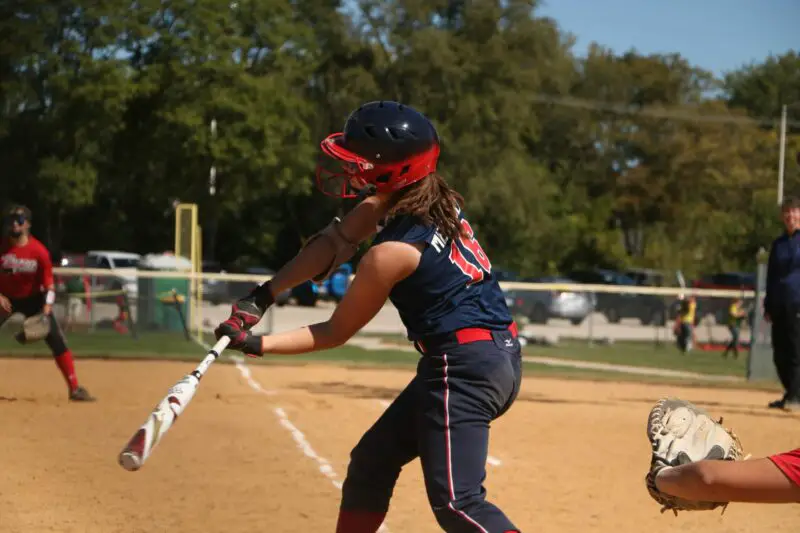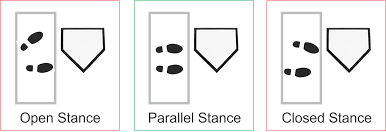
Most times when the batter arrives at the plate, they are thinking about hitting the ball as hard and as far as possible. Softball place hitting is a useful tool for may reasons including when it is necessary to move a runner or as a tool to hit a weak area of the field. This is when it is not the power in the swing that is most important but the ability to control the bat and the direction of the ball.
Softball Place Hitting
This is achieved by considering a few factors while at bat.
- The angle of the bat
- The distance from the plate
- The placement of the feet
- The weight of the bat
- The speed of the pitch
- The timing of the swing
- The Purpose of the at bat
The angle of the bat:

As you can see from the diagram, the angle of the bat will have the ball react on contact in the direction that the contact part of the bat is facing.
Where the hands are on the bat when contact is made will also impact the angle of the bat on contact. For example if the batter had her hands close to the barrel of the bat, she would have to move the bat further ahead of the plate to make contact with the ball. This would have the bat more in a pull hitting position as the core of the body rotates during movement. It could also have the batter miss the ball because the bat is further away from the plate when it gets to the ball.
The distance from the plate:
The distance that the batter is from the pitcher will most times effect the angle of the bat because of where the contact is made. If the batter is closer to the pitcher for example, it is likely that the angle will be to the opposite field because there is less time for the batter to get the bat around to the ball. If the batter is closer to the catcher, there is a good chance that the angle will be more to the pull side of the field because there is more time to get the bat around to the ball.
If the batter is closer to the plate, she most times can not extend her arms fully on contact so it will be more of an opposite field hit. If she is further away from the plate, she may pull the ball because she is fully extending her arms, but she might also simply miss or hit the ball off the end of the bat because she can not fully reach the ball.
Placement of the feet:

The placement of the feet will also effect the bat angle. An open stance will pull the ball to the dominant side, a parallels stance will have a better chance of sending the ball up the middle and a closed stance will have a good chance of sending the ball to the opposite side. An open stance is also used sometimes when the batter is having a hard time seeing the ball.
The weight of the bat:
The weight of the bat will effect the speed of the swing. A lighter bat will bring it to the ball sooner which will often send the ball to the pull side because the angle of it will be more to that side. If the bat is heavier, there is a better chance that the ball will end up closer to the middle or opposite side of the field due to the amount of time it takes to get the bat to the ball.
The speed of the ball:
If the ball is coming at the batter quickly, there is a good chance that the contact will be made sooner than the hitter might want it to. This would have the bat contact with it angled to the opposite field. It makes sense that if the ball is coming quicker than we are ready for, the hitter will hit the ball sooner.
If the ball is coming slower than normal, the swing might bring the bat through the strike zone quicker which will make the batter pull the ball down the field on their dominant side.
A good hit up the middle will happen when the batter is confident in her abilities and can handle the speed of the ball with ease.
The timing of the swing:
This is a very difficult skill to master when there are other ways to have the same effect on the ball. One way that a player could effect the timing of the swing is to use the placement of the hands on the bat to either shorten or lengthen the amount of the bat that goes through the strike zone. A shorter bat will go much quicker through the zone than a longer one and will effect the direction of the ball because of the angle of the bat at contact. This is also a good way to help the players make contact if they are having trouble at the plate.
The purpose of the at bat:
Every batter goes to the plate with a goal in mind. Or they should at least. This will depend on weather there is a runner or runners on base, where the players are positioned on the defense and sometimes the skill level of the defense. With this in mind, the batter will position herself in the batters box in such a way as to achieve the closest thing that she can to the desired outcome of the hit. This may or may not include the need for softball place hitting.
Many hitters will have a natural tendency when they hit. Some are opposite field hitters who hit the right field if they are a right handed batter and left field if they are a left handed batter. When hitting to the opposite field it is difficult to get real power on the ball because its like only half of the body is used. There is generally no full rotation and the arms do not fully extend so the hitter can not use all of her core strength.
Someone who generally hits up the middle will often get on base because it can be the hardest part of the field to defend. These hitters often also have more success with softball place hitting because they have good control of the bat and can see the ball well.
A pull hitter can get a lot of power on the ball because she maximizes all of her strength and generally gets her hands fully extended to the ball. This hitter will hit down the left field line for a right handed hitter and right field line for a left handed hitter. This can be an advantage and a disadvantage for the hitter. It can be an advantage because the fence is easier to get to if all of her strength is used. The disadvantage is that if she consistently pulls the ball, she is easy to defend because the pitcher and the defenders know her tendencies.
Things to remember:
When talking about place hitting, assumptions are made based on the pitched ball being predictably straight on the batter. There are many variables to consider when calling for a specific location to hit to. This includes the experience of the batter, the experience of the pitcher and the desired outcome of the at bat.
It is important to remember that given the game situation, the environment and the confidence of the batter, place hitting may not happen the way it was intended. Everything in this game is dependent on many factors that can effect the outcome of the execution of any skill. Keeping this in mind will lessen some of the stress that comes with perceived failure.
